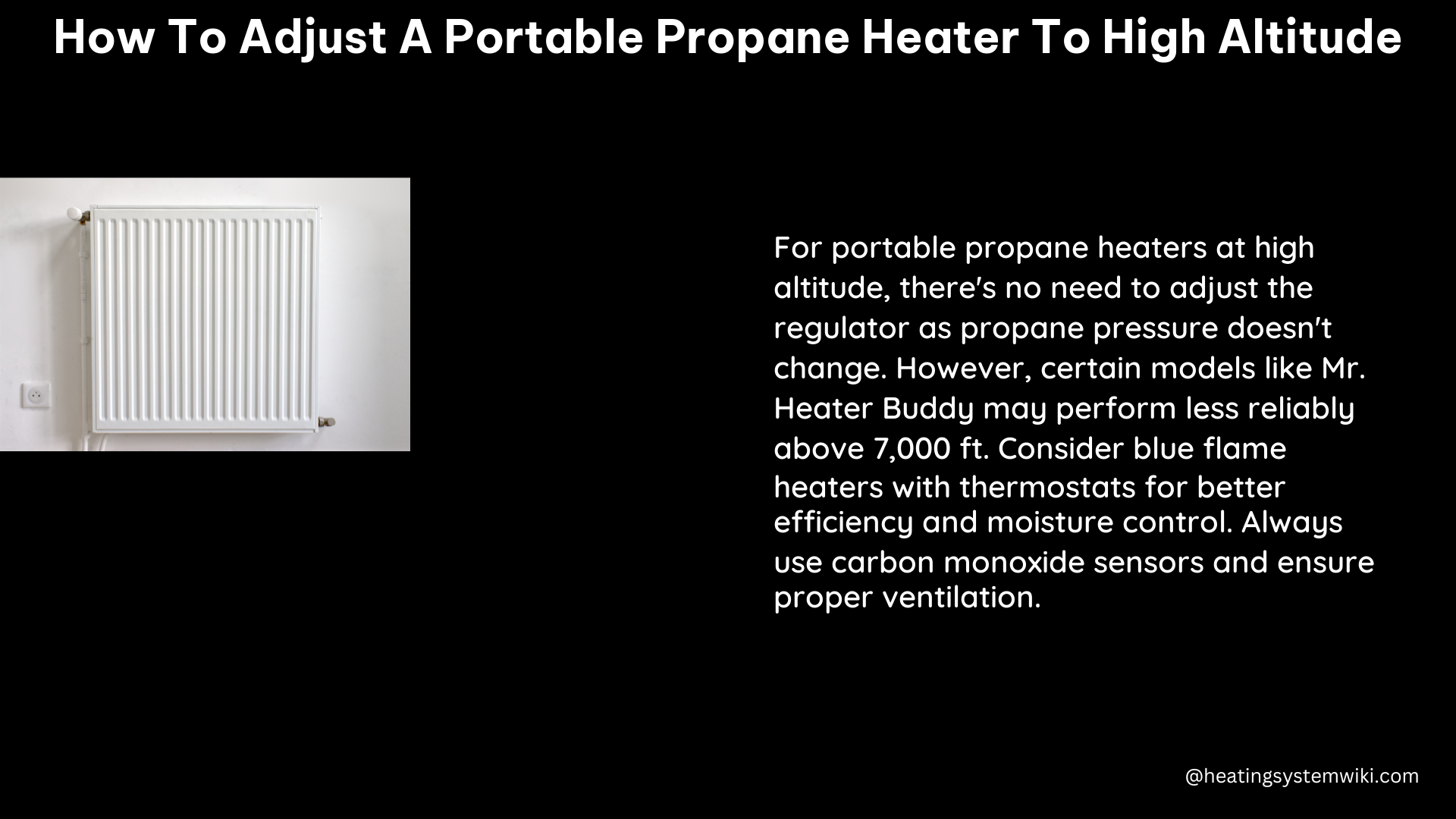When using a portable propane heater at high altitudes, it’s essential to make adjustments to ensure efficient and safe operation. The lower atmospheric pressure at higher elevations can affect the combustion process, potentially leading to incomplete burning and the production of harmful byproducts. By following the steps outlined in this comprehensive guide, you can properly adjust your portable propane heater for optimal performance and safety in high-altitude environments.
Understanding the Impact of High Altitude
As you ascend in elevation, the atmospheric pressure decreases. This lower pressure affects the combustion process within the portable propane heater, as the reduced oxygen levels can lead to incomplete burning of the fuel. The result is a less efficient heat output and the potential for the production of carbon monoxide, a highly toxic gas.
To compensate for these changes, you’ll need to make adjustments to the propane pressure and monitor the flame appearance to ensure proper combustion and safe operation.
Adjusting the Propane Pressure

The primary adjustment you’ll need to make is to the propane pressure. The goal is to reduce the pressure slightly to match the lower atmospheric pressure at high altitudes.
Using a Manometer
The most accurate way to adjust the propane pressure is by using a manometer, a device that measures the pressure of the gas. Here’s how to use a manometer to adjust your portable propane heater:
-
Obtain a Manometer: Purchase or rent a digital or analog manometer that is compatible with your portable propane heater. Ensure that the manometer can measure the appropriate pressure range, typically in inches of water column (in. w.c.) or millibars (mbar).
-
Connect the Manometer: Locate the propane pressure test port on your heater, usually near the gas inlet or regulator. Attach the manometer to this port, following the manufacturer’s instructions.
-
Measure the Baseline Pressure: With the heater running, note the propane pressure reading on the manometer. This will be your baseline pressure.
-
Adjust the Pressure: Locate the adjustment screw or knob on the propane regulator. Slowly turn the adjustment mechanism to reduce the pressure until the manometer reading matches the recommended pressure for your altitude. Refer to the manufacturer’s guidelines or industry standards for the appropriate pressure settings at different elevations.
-
Verify the Flame Appearance: Observe the flame appearance after adjusting the pressure. The flame should be blue and steady, without excessive yellow tips or flickering. If the flame appears too weak or unstable, you may need to make further adjustments to the propane pressure.
Adjusting Without a Manometer
If you don’t have access to a manometer, you can try adjusting the propane pressure based on the flame appearance. However, this method is less precise and may require more trial and error:
-
Observe the Flame: Start the portable propane heater and observe the flame. Ideally, the flame should be blue and steady, with minimal yellow tips.
-
Adjust the Pressure: Locate the adjustment screw or knob on the propane regulator. Slowly turn the adjustment mechanism to reduce the pressure. Observe the flame and continue adjusting until the flame appears blue and stable.
-
Monitor the Flame Continuously: As you use the heater, periodically check the flame appearance. If the flame becomes too weak or unstable, you may need to make further adjustments to the propane pressure.
Choosing a Suitable Portable Propane Heater for High Altitude
Not all portable propane heaters are designed for high-altitude use. Some models may be less reliable or even potentially dangerous at higher elevations due to the thinner oxygen levels. When selecting a portable propane heater for use in high-altitude areas, look for models that are specifically rated or approved for high-altitude operation.
Manufacturers often provide guidance on the maximum recommended altitude for their heaters. For example, the Mr. Heater Buddy is less suitable for high-altitude use, while the Mr. Heater Big Maxx 80,000 BTU unit is designed to perform well at elevations up to 7,000 feet (2,134 meters).
Maintaining Safe Operation
Regardless of the adjustments made, it’s crucial to continuously monitor the portable propane heater’s performance and safety when operating at high altitudes. Pay close attention to the flame appearance, any changes in heat output, and the potential for the production of carbon monoxide or other harmful byproducts.
If you notice any concerning changes or have doubts about the heater’s operation, immediately turn it off and consult the manufacturer or a qualified technician for further guidance.
Conclusion
Adjusting a portable propane heater for high-altitude use requires careful attention to the propane pressure and flame appearance. By using a manometer to make precise pressure adjustments or by closely monitoring the flame, you can ensure your heater operates efficiently and safely at elevated locations. Remember to choose a heater that is designed for high-altitude use and to follow the manufacturer’s instructions closely. With the right adjustments and precautions, you can enjoy the warmth of your portable propane heater even in the most challenging high-altitude environments.
